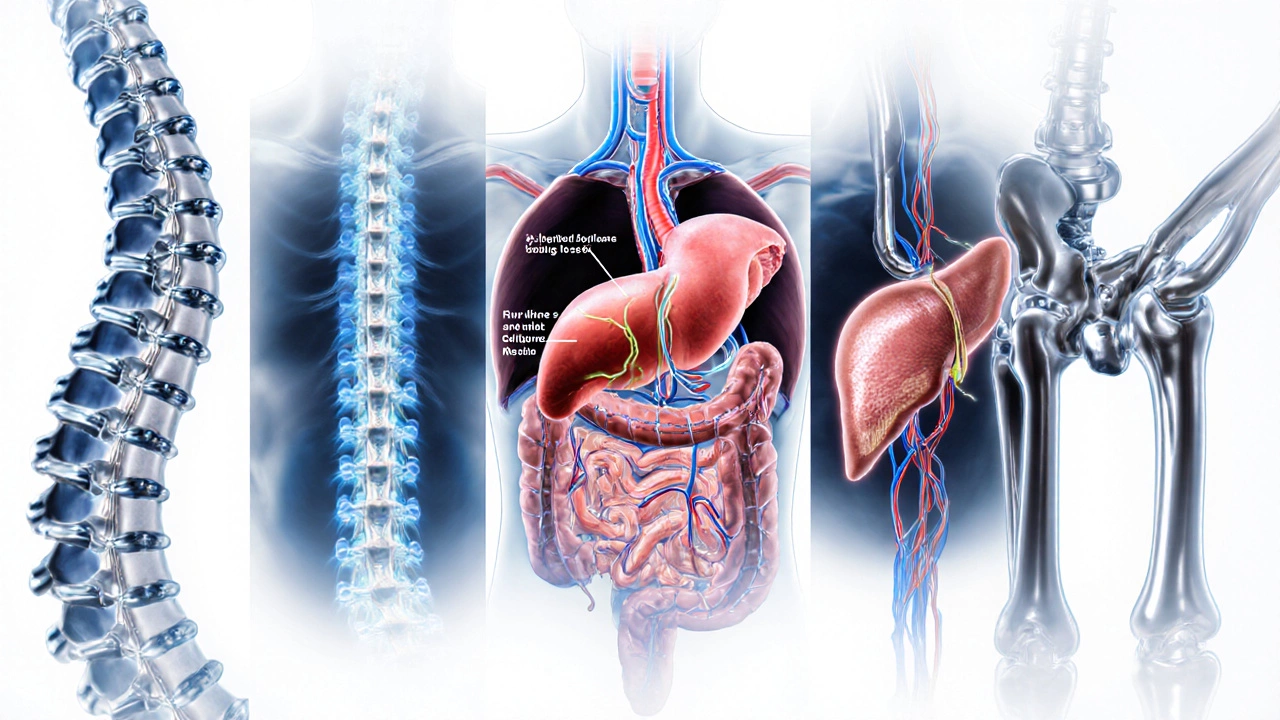Surgery Recovery Comparison Tool
Compare Your Surgery Recovery
Select one or more surgeries to see detailed recovery timelines, complications, and personalized tips.
Select surgeries to compare their recovery timelines and complications
Click on surgery options above and press "Compare Selections"
Ever wondered which operation feels like climbing a mountain after the scalpel is put away? Recovery isn’t just about healing a cut; it’s about how the body copes with trauma, how long you stay off work, and what daily chores become impossible. Below we break down the surgeries that doctors call the most demanding to bounce back from, why they are so tough, and what you can do to make the journey smoother.
Key Takeaways
- Recovery difficulty hinges on tissue type involved, organ function loss, and post‑operative complications.
- Spinal fusion, heart and liver transplants, the Whipple procedure, and major joint replacements top the list.
- Full recovery can range from 3months (joint replacement) to 12months or more (organ transplants).
- Early mobilization, nutrition, pain control, and clear communication with your surgical team cut down setbacks.
- Watch for red‑flag signs-persistent fever, sudden swelling, or unexplained weakness-to avoid emergency readmissions.
How We Judge Recovery Difficulty
Doctors look at three main factors when they say a surgery has a hard recovery:
- Physiological stress: Does the procedure involve major organs or the central nervous system?
- Risk of post‑operative complications: Infection, bleeding, organ rejection, or nerve damage.
- Impact on daily function: How long before you can walk, eat normally, or return to work?
Combining these gives a practical rank‑order that patients and surgeons use to set expectations.
1. Spinal Fusion
Spinal fusion is a surgical technique that joins two or more vertebrae using bone grafts, metal rods, or screws. The goal is to stop painful movement caused by disc degeneration, scoliosis, or spinal fractures. Because the spine houses the spinal cord, any swelling or hardware irritation can trigger nerve symptoms that linger for months. Typical hospital stay: 3‑5days; full recovery: 4‑12months. Major risks include hardware failure, adjacent‑segment disease, and chronic back pain.
2. Pancreaticoduodenectomy (Whipple Procedure)
Pancreaticoduodenectomy, commonly called the Whipple procedure, removes the head of the pancreas, part of the duodenum, gallbladder, and sometimes a portion of the stomach. It’s used for pancreatic cancer or severe chronic pancreatitis. The surgery reshapes the digestive tract, so patients face delayed gastric emptying, enzyme deficiencies, and a high chance of infection. Hospital stay often 10‑14days; complete recovery can take 6‑12months, with many needing lifelong enzyme supplements.

3. Heart Transplant
Heart transplant replaces a failing heart with a donor organ. While it gives a new lease on life, the body must accept the foreign tissue, requiring intense immunosuppression. Hospitalization usually 2‑3weeks in intensive care, followed by 6‑12months of medication adjustments and physical rehab. Risks include organ rejection, infection, and renal complications.
4. Liver Transplant
Liver transplant removes a diseased liver and replaces it with a donor organ. Like heart transplants, it demands strict immune‑suppressive therapy, careful monitoring of liver function, and avoidance of alcohol or hepatotoxic drugs. Hospital stay averages 10‑14days; most patients need 9‑12months before they feel ‘normal.’ Major complications: bile duct strictures, rejection episodes, and infections.
5. Major Joint Replacement (Hip or Knee)
Hip replacement (or knee replacement) substitutes the damaged joint with a prosthetic implant. Though it’s called “elective,” the surgery involves cutting bone, inserting metal components, and managing postoperative pain. Hospital stay 2‑4days; most patients resume light activities within 6‑8weeks, but reaching full strength often takes 4‑6months. Risks: prosthetic dislocation, infection, and blood clots.
Recovery Timeline Comparison
| Surgery | Typical Hospital Stay | Average Full Recovery Time | Key Complication(s) |
|---|---|---|---|
| Spinal Fusion | 3‑5 days | 4‑12 months | Hardware failure, nerve irritation |
| Whipple Procedure | 10‑14 days | 6‑12 months | Delayed gastric emptying, enzyme deficiency |
| Heart Transplant | 2‑3 weeks (ICU) | 6‑12 months | Rejection, infection, renal issues |
| Liver Transplant | 10‑14 days | 9‑12 months | Bile duct strictures, rejection |
| Hip/Knee Replacement | 2‑4 days | 4‑6 months | Dislocation, infection, clotting |

Practical Tips to Smooth the Road
Even the toughest recovery becomes manageable when you follow evidence‑backed habits:
- Start moving early: Within 24‑48hours, sit up, swing legs, and do breathing exercises to keep circulation flowing.
- Nutrition matters: Protein‑rich meals (30‑40g per meal) support tissue repair; consider whey or soy supplements if appetite drops.
- Control pain strategically: Combine scheduled non‑opioid analgesics (acetaminophen + ibuprofen) with short‑term opioids only for breakthrough pain.
- Follow rehab plans: Physical therapists design progressive strength drills that prevent stiffness and protect the surgical site.
- Watch your meds: Immunosuppressants after transplants require precise timing and blood‑level checks; missing a dose can trigger rejection.
- Stay hydrated: Fluid intake of at least 2liters per day reduces clot risk and aids kidney function, especially after major organ surgery.
Common Pitfalls and How to Avoid Them
Many setbacks arise from simple missteps:
| Pitfall | Consequence | Prevention |
|---|---|---|
| Skipping early ambulation | Deep‑vein thrombosis | Set hourly alarms for short walks |
| Ignoring wound drainage | Infection or dehiscence | Inspect incision daily, report any foul smell |
| Over‑relying on opioids | Constipation, dependency | Use scheduled NSAIDs, add stool softeners |
| Neglecting nutrition | Delayed tissue healing | Track protein intake with a food diary |
| Missing immunosuppressive doses | Organ rejection | Keep meds in a pill organizer with alarms |
When to Call Your Surgeon or Emergency Services
Red‑flag symptoms never wait for an appointment. Act immediately if you notice:
- Fever >38.5°C (101.3°F) lasting more than 24hours.
- Sudden swelling, redness, or increasing pain at the incision site.
- Shortness of breath, chest pain, or palpitations after heart‑related surgery.
- Unexplained dizziness, severe nausea, or vomiting that doesn’t improve.
- Changes in urine color (dark or tea‑colored) after liver or kidney procedures.
Quick intervention can prevent a minor issue from turning into a life‑threatening one.
Frequently Asked Questions
Which surgery has the longest overall recovery?
Heart and liver transplants typically require the longest adjustment period-up to a year for full functional recovery-because they combine major organ replacement, lifelong medication management, and intensive rehabilitation.
Can I work while recovering from a joint replacement?
Most patients return to desk jobs within 6‑8 weeks, but heavy lifting or long standing should be avoided for at least 4‑5 months to protect the new implant.
Do I need a caregiver at home after a spinal fusion?
Having a caregiver for the first 2‑3 weeks is highly recommended. They can help with transfers, medication reminders, and monitoring for any sudden neurological changes.
What nutritional supplements aid recovery after the Whipple procedure?
Pancreatic enzyme tablets, medium‑chain triglyceride (MCT) oil, and a high‑protein oral supplement (e.g., whey isolate) are commonly prescribed to offset digestion issues and boost calorie intake.
Is pain always a sign of a complication?
Not necessarily. Some discomfort is expected as tissues heal. However, sharp, worsening, or radiating pain should be reported promptly, as it may indicate infection, nerve irritation, or vascular issues.
